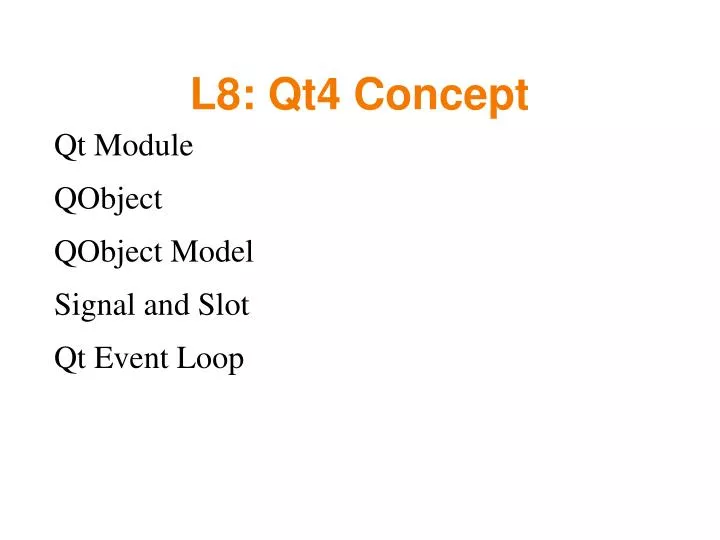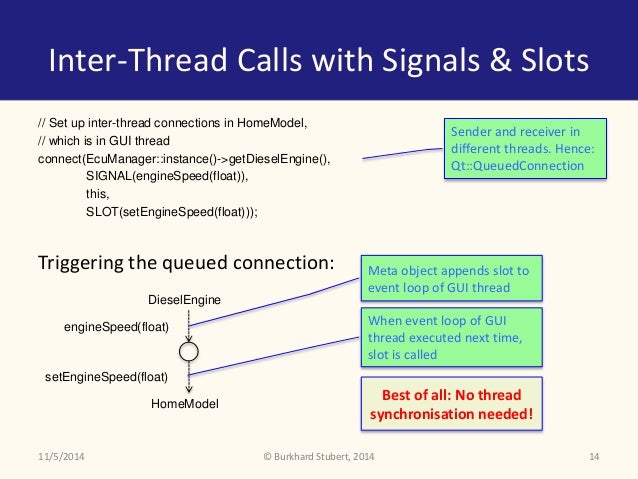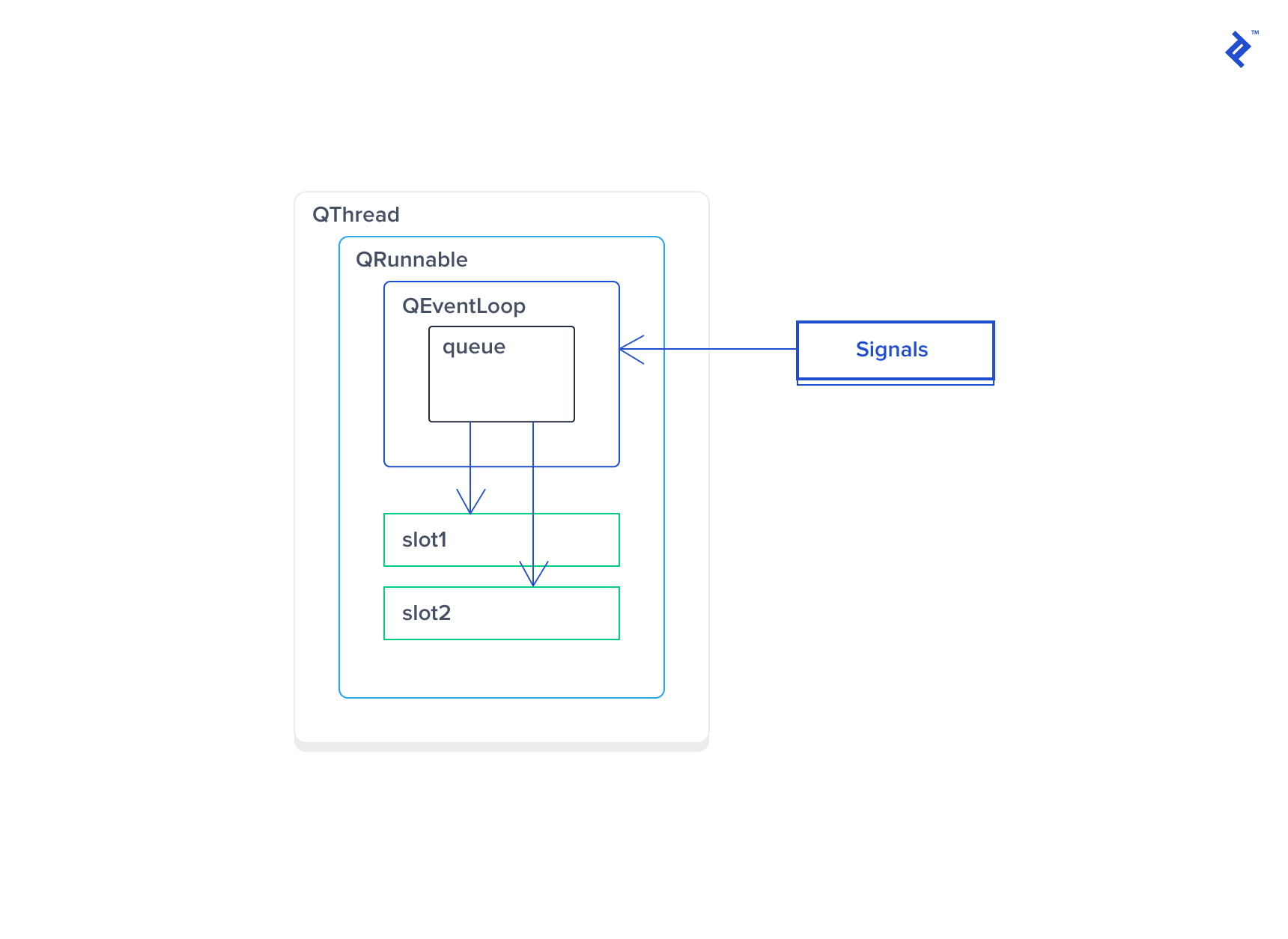- Qt Signals And Slots Without Event Loops
- Qt Signals And Slots Without Event Loop Download
- Qt Signals And Slots Without Event Loop Free
- Qt Signals And Slots Without Event Loop Youtube
| Home All Classes Main Classes Annotated Grouped Classes Functions |
There are several ways to connect a signal in Qt 5. Qt 5 continues to support the old string-based syntax for connecting signals and slots defined in a QObject or any class that inherits from QObject (including QWidget) connect( sender, SIGNAL( valueChanged( QString, QString ) ), receiver, SLOT( updateValue( QString ) ) ). The connection mechanism uses a vector indexed by signals. But all the slots waste space in the vector and there are usually more slots than signals in an object. So from Qt 4.6, a new internal signal index which only includes the signal index is used. While developing with Qt, you only need to know about the absolute method index. The main loop fetches events and sends them to the objects. Qt has a unique signal and slot mechanism. This signal and slot mechanism is an extension to the C programming language. Signals and slots are used for communication between objects. A signal is emitted when a particular event occurs. A slot is a normal C method; it is called when. Signals & Slots Signals and slots are used for communication between objects. The signals and slots mechanism is a central feature of Qt and probably the part that differs most from the features provided by other frameworks. Signals and slots are made possible by Qt's meta-object system.
Signals and slots are used for communication between objects. Thesignal/slot mechanism is a central feature of Qt and probably thepart that differs most from other toolkits.
In GUI programming we often want a change in one widget to be notifiedto another widget. More generally, we want objects of any kind to beable to communicate with one another. For example if we were parsingan XML file we might want to notify a list view that we're using torepresent the XML file's structure whenever we encounter a new tag.
Older toolkits achieve this kind of communication using callbacks. Acallback is a pointer to a function, so if you want a processingfunction to notify you about some event you pass a pointer to anotherfunction (the callback) to the processing function. The processingfunction then calls the callback when appropriate. Callbacks have twofundamental flaws. Firstly they are not type safe. We can never becertain that the processing function will call the callback with thecorrect arguments. Secondly the callback is strongly coupled to theprocessing function since the processing function must know whichcallback to call.
An abstract view of some signals and slots connections
In Qt we have an alternative to the callback technique. We use signalsand slots. A signal is emitted when a particular event occurs. Qt'swidgets have many pre-defined signals, but we can always subclass toadd our own. A slot is a function that is called in reponse to aparticular signal. Qt's widgets have many pre-defined slots, but it iscommon practice to add your own slots so that you can handle thesignals that you are interested in.
The signals and slots mechanism is type safe: the signature of asignal must match the signature of the receiving slot. (In fact a slotmay have a shorter signature than the signal it receives because itcan ignore extra arguments.) Since the signatures are compatible, thecompiler can help us detect type mismatches. Signals and slots areloosely coupled: a class which emits a signal neither knows nor careswhich slots receive the signal. Qt's signals and slots mechanismensures that if you connect a signal to a slot, the slot will becalled with the signal's parameters at the right time. Signals andslots can take any number of arguments of any type. They arecompletely typesafe: no more callback core dumps!
All classes that inherit from QObject or one of its subclasses(e.g. QWidget) can contain signals and slots. Signals are emitted byobjects when they change their state in a way that may be interestingto the outside world. This is all the object does to communicate. Itdoes not know or care whether anything is receiving the signals itemits. This is true information encapsulation, and ensures that theobject can be used as a software component.
An example of signals and slots connections
Slots can be used for receiving signals, but they are also normalmember functions. Just as an object does not know if anything receivesits signals, a slot does not know if it has any signals connected toit. This ensures that truly independent components can be created withQt.
You can connect as many signals as you want to a single slot, and asignal can be connected to as many slots as you desire. It is evenpossible to connect a signal directly to another signal. (This willemit the second signal immediately whenever the first is emitted.)
Together, signals and slots make up a powerful component programmingmechanism.
A Small Example
A minimal C++ class declaration might read:
A small Qt class might read:
This class has the same internal state, and public methods to access thestate, but in addition it has support for component programming usingsignals and slots: this class can tell the outside world that its statehas changed by emitting a signal, valueChanged(), and it hasa slot which other objects can send signals to.
All classes that contain signals or slots must mention Q_OBJECT intheir declaration.
Slots are implemented by the application programmer.Here is a possible implementation of Foo::setValue():
The line emit valueChanged(v) emits the signalvalueChanged from the object. As you can see, you emit asignal by using emit signal(arguments).
Here is one way to connect two of these objects together:
Calling a.setValue(79) will make a emit a valueChanged()signal, which b will receive in its setValue() slot,i.e. b.setValue(79) is called. b will then, in turn,emit the same valueChanged() signal, but since no slot has beenconnected to b's valueChanged() signal, nothing happens (thesignal is ignored).
Note that the setValue() function sets the value and emitsthe signal only if v != val. This prevents infinite loopingin the case of cyclic connections (e.g. if b.valueChanged()were connected to a.setValue()).
A signal is emitted for every connection you make, so if youduplicate a connection, two signals will be emitted. You can alwaysbreak a connection using QObject::disconnect().
This example illustrates that objects can work together without knowingabout each other, as long as there is someone around to set up aconnection between them initially.
The preprocessor changes or removes the signals, slots andemit keywords so that the compiler is presented with standard C++.
Run the moc on class definitions that containsignals or slots. This produces a C++ source file which should be compiledand linked with the other object files for the application. If you useqmake, the makefile rules toautomatically invoke the moc will be added toyour makefile for you.
Signals
Signals are emitted by an object when its internal state has changedin some way that might be interesting to the object's client or owner.Only the class that defines a signal and its subclasses can emit thesignal.
A list box, for example, emits both clicked() andcurrentChanged() signals. Most objects will probably only beinterested in currentChanged() which gives the current list itemwhether the user clicked it or used the arrow keys to move to it. Butsome objects may only want to know which item was clicked. If thesignal is interesting to two different objects you just connect thesignal to slots in both objects.
When a signal is emitted, the slots connected to it are executedimmediately, just like a normal function call. The signal/slotmechanism is totally independent of any GUI event loop. Theemit will return when all slots have returned.
If several slots are connected to one signal, the slots will beexecuted one after the other, in an arbitrary order, when the signalis emitted.
Signals are automatically generated by the mocand must not be implemented in the .cpp file. They can never havereturn types (i.e. use void).
A note about arguments. Our experience shows that signals and slotsare more reusable if they do not use special types. If QScrollBar::valueChanged() were to use a special type such as thehypothetical QRangeControl::Range, it could only be connected toslots designed specifically for QRangeControl. Something as simple asthe program in Tutorial #1 part 5would be impossible.
Slots
A slot is called when a signal connected to it is emitted. Slots arenormal C++ functions and can be called normally; their only specialfeature is that signals can be connected to them. A slot's argumentscannot have default values, and, like signals, it is rarely wise touse your own custom types for slot arguments.
Since slots are normal member functions with just a little extraspice, they have access rights like ordinary member functions. Aslot's access right determines who can connect to it:
A public slots section contains slots that anyone can connectsignals to. This is very useful for component programming: you createobjects that know nothing about each other, connect their signals andslots so that information is passed correctly, and, like a modelrailway, turn it on and leave it running.
A protected slots section contains slots that this class and itssubclasses may connect signals to. This is intended for slots that arepart of the class's implementation rather than its interface to therest of the world.
A private slots section contains slots that only the class itselfmay connect signals to. This is intended for very tightly connectedclasses, where even subclasses aren't trusted to get the connectionsright.
You can also define slots to be virtual, which we have found quiteuseful in practice.
The signals and slots mechanism is efficient, but not quite as fast as'real' callbacks. Signals and slots are slightly slower because of theincreased flexibility they provide, although the difference for realapplications is insignificant. In general, emitting a signal that isconnected to some slots, is approximately ten times slower thancalling the receivers directly, with non-virtual function calls. Thisis the overhead required to locate the connection object, to safelyiterate over all connections (i.e. checking that subsequent receivershave not been destroyed during the emission) and to marshall anyparameters in a generic fashion. While ten non-virtual function callsmay sound like a lot, it's much less overhead than any 'new' or'delete' operation, for example. As soon as you perform a string,vector or list operation that behind the scene requires 'new' or'delete', the signals and slots overhead is only responsible for avery small proportion of the complete function call costs. The same istrue whenever you do a system call in a slot; or indirectly call morethan ten functions. On an i586-500, you can emit around 2,000,000signals per second connected to one receiver, or around 1,200,000 persecond connected to two receivers. The simplicity and flexibility ofthe signals and slots mechanism is well worth the overhead, which yourusers won't even notice.
Meta Object Information
Qt Signals And Slots Without Event Loops

The meta object compiler (moc) parses the classdeclaration in a C++ file and generates C++ code that initializes themeta object. The meta object contains the names of all the signal andslot members, as well as pointers to these functions. (For moreinformation on Qt's Meta Object System, see Whydoesn't Qt use templates for signals and slots?.)
The meta object contains additional information such as the object's class name. You can also check if an objectinherits a specific class, for example:
A Real Example
Here is a simple commented example (code fragments from qlcdnumber.h ).
QLCDNumber inherits QObject, which has most of the signal/slotknowledge, via QFrame and QWidget, and #include's the relevantdeclarations.
Q_OBJECT is expanded by the preprocessor to declare several memberfunctions that are implemented by the moc; if you get compiler errorsalong the lines of 'virtual function QButton::className not defined'you have probably forgotten to run the moc or toinclude the moc output in the link command.
It's not obviously relevant to the moc, but if you inherit QWidget youalmost certainly want to have the parent and namearguments in your constructors, and pass them to the parentconstructor.
Some destructors and member functions are omitted here; the mocignores member functions.
QLCDNumber emits a signal when it is asked to show an impossiblevalue.
If you don't care about overflow, or you know that overflow cannotoccur, you can ignore the overflow() signal, i.e. don't connect it toany slot.
If, on the other hand, you want to call two different error functionswhen the number overflows, simply connect the signal to two differentslots. Qt will call both (in arbitrary order).
A slot is a receiving function, used to get information about statechanges in other widgets. QLCDNumber uses it, as the code aboveindicates, to set the displayed number. Since display() is partof the class's interface with the rest of the program, the slot ispublic.
Several of the example programs connect the newValue() signal of aQScrollBar to the display() slot, so the LCD number continuously showsthe value of the scroll bar.
Note that display() is overloaded; Qt will select the appropriate versionwhen you connect a signal to the slot. With callbacks, you'd have to findfive different names and keep track of the types yourself.

Some irrelevant member functions have been omitted from thisexample.
Qt documentation states that signals and slots can be direct, queued and auto.
It also stated that if object that owns slot ‘lives’ in a thread different from object that owns signal, emitting such signal will be like posting message – signal emit will return instantly and slot method will be called in target thread’s event loop.
Unfortunately, documentation do not specify that ‘lives’ stands for and no examples is available. I have tried the following code:
main.h:

main.cpp:
Output is:
MySlot() is never called :(. What I’m doing wrong?
There are quite a few problems with your code :
- like said by Evan the emit keyword is missing
- all your objects live in the main thread, only the code in the run methods live in other threads, which means that the MySlot slot would be called in the main thread and I’m not sure that’s what you want
- your slot will never be called since the main event loop will never been launched : your two calls to wait() will only timeout after a very long time (and you’ll probably kill your application before that happens) and I don’t think that’s what you want either, anyway they really have no use in your code.
This code would most likely work (though I have not tested it) and I think it does what you want it to do :
Now MyObject will live in thread2 (thanks to moveToThread).
MySignal should be sent from thread1 (thought I’m not sure on that one, it might be sent from main thread, it doesn’t really matter).
No event loop is needed in thread1 since emitting a signal doesn’t need an event loop. An event loop is needed in thread2 (lanched by exec()) to receive the signal.
Qt Signals And Slots Without Event Loop Download
MySlot will be called in thread2.
Do not subclass QThread for Qt 4.4+
While Aiua’s answer is good, I want to point out some issues with QThread and Qt 4.6 or 4.7.

This article sums it up: http://blog.qt.io/blog/2010/06/17/youre-doing-it-wrong/
Lack of Documentation on Qt’s part

Qt Signals And Slots Without Event Loop Free
Unfortunately the problem stems from a lack of updates to documentation. Prior to Qt 4.4 QThread had no default run() implementation, which meant that you had to subclass QThread in order to use it.
If you’re using Qt 4.6 or 4.7 then you almost certainly should not subclass QThread.
Use moveToThread
Qt Signals And Slots Without Event Loop Youtube
The key to getting slots to execute in a worker thread is to use the moveToThread method as Aiua pointed out.
Tags: qt